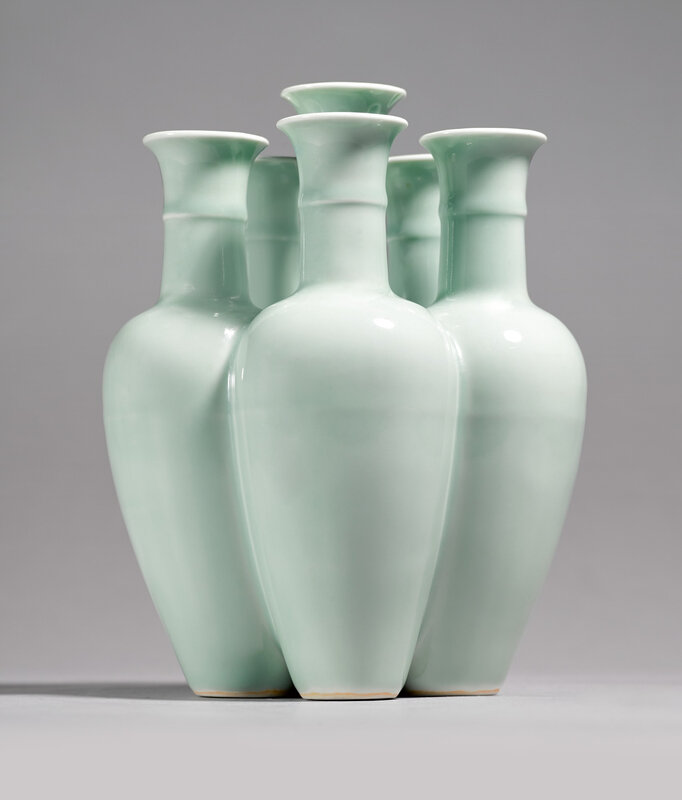Sotheby's. Imperial Porcelain – A Private Collection, London, 4 November 2020
A very rare celadon-glazed conjoined vase, Yongzheng mark and period (1723-1735)




Lot 14. A very rare celadon-glazed conjoined vase, Yongzheng mark and period (1723-1735). Height 24 cm, 9½ in. Estimate: 250,000 - 350,000 GBP. Lot sold: 583,700 GBP. Courtesy Sotheby's.
superbly potted as six conjoined amphora-shaped vases, each with an ovoid body gently rising to a high rounded shoulder and a tall cylindrical neck encircled with a filet and surmounted by a wide flaring rim, covered overall with a viterous pale-celadon glaze save for the footrims, the base of the central vase with a six-character seal mark in underglaze blue.
Provenance: Sotheby's Hong Kong, 1st November 1994, lot 113.
Note: This rare vase is an exceptional example of the technical and artistic perfection achieved at the imperial kilns in Jingdezhen during the reign of the Yongzheng emperor. Its sophisticated form and cool celadon glaze, which are deeply rooted in the ceramic tradition of the Song dynasty (960-1279), encapsulate the emperor’s penchant for these early wares and his insistence on outstanding quality.
The imperial kiln factory in Jingdezhen experienced one of its most flourishing periods under the watchful eye of the Yongzheng Emperor. The emperor’s fervent love and astute knowledge of the antiques in the imperial collection stimulated potters to create unique and exquisitely crafted wares that were both technically challenging and steeped in historical symbolism, such as this vase. While conjoined vases were made in ceramic form from as early as the Neolithic period, this piece is more likely to have been inspired by multi-spouted vases and jars popular in the Song dynasty. Made at the Longquan kilns in southern Zhejiang province, these jars were used to store grain in tombs, and were believed to secure the eternal well-being of a family. One such jar was recovered from Suining, Sichuan province, and illustrated in Song yun, Sichuan Jiaocang wenwu jicui [Selected relics from the Sichuan hoards], Beijing, 2006, pl. 36.
Conjoined vases were first made at Jingdezhen during the reign of the Yonzheng Emperor and their form is a testament to the potters’ technical know-how, as they were particularly difficult to fire successfully. During the firing, the proximity of the neck and mouth of the vessels increased the risk of warping. Used for displaying flowers, conjoined vases began to be produced early in the Yongzheng reign as can be glimpsed from an entry in the Qing court archives dated to the fourth year of the reign (corresponding to 1726), which mentions a five-spouted vase made at the falang (enamelling) workshop on the 7th month of that year, and a six-spouted vase made a month later (The Enchanting Splendor of Vases and Planters: A Special Exhibition of Flower Vessels from the Ming and Qing Dynasties, National Palace Museum, Taipei, 2014, pl. II-04).
Celadon vases of this form are very rare, although a very similar vase from the Ohlmer collection in the Roemer Museum, Hildesheim, is illustrated in Ulrich Wiesner, Chinesisches Porzellan, Mainz am Rhein, 1981, pl. 88. See also a vase of this form, but decorated in white slip with a band of ruyi on the shoulder and beads on the neck, from the collection of Lord Hollenden, sold in these rooms in 1973 and in our Hong Kong rooms, 15th May 1990, lot 81.
Conjoined vases peaked in popularity during the Qianlong period (r. 1736-1795), when examples were covered in a variety of monochrome glazes and painted in blue and white. A Qianlong mark and period vase of this form and glaze, is illustrated in Chinese Porcelain. S.C. Ko Tianminlou Collection, Hong Kong, 1987, pl. 149; another from the collections of Sir Edmund Rathbone Bacon and Robert May, was sold in our New York rooms, 20th March 2012, lot 237; a tea-dust glazed example in the National Palace Museum, Taipei (accession no. C1B002902N000000000PAB), was included in the museum’s Special Exhibition of K’ang-hsi, Yung-cheng and Ch’ien-lung Porcelain Ware from the Ch’ing Dynasty in the National Palace Museum, Taipei, 1986, p. 123, pl. 96; and a blue and white vase in the Palace Museum, Beijing (accession no. 00152940), is illustrated in Kangxi, Yongzheng, Qianlong. Qing Porcelain from the Palace Museum Collection, Beijing, 1989, pl. 32.

From the collections of Sir Edmund Rathbone Bacon and Robert May. A rare celadon-glazed six-necked vase (Liukongping), Qianlong seal mark and period. Height 8 3/4 in., 22.5 cm. Estimate 70,000-90,000 USD. Lot sold 572,500 USD at New York, 20 March 2012, lot 237. Photo Sotheby's
Cf. my post: A rare celadon-glazed six-necked vase (Liukongping), Qianlong seal mark and period

Six conjoined vases with tea-dust glaze, Qing dynasty, Qianlong reign (1736-1795), National Palace Museum, Taipei (accession no. C1B002902N000000000PAB). © National Palace Museum.

Qianlong blue and white lotus flask with lotus motifs, Palace Museum, Beijing (accession no. 00152940).

/https%3A%2F%2Fprofilepics.canalblog.com%2Fprofilepics%2F1%2F0%2F100183.jpg)
/https%3A%2F%2Fstorage.canalblog.com%2F03%2F02%2F119589%2F96711876_o.jpg)
/https%3A%2F%2Fstorage.canalblog.com%2F11%2F31%2F119589%2F94773502_o.jpg)
/https%3A%2F%2Fstorage.canalblog.com%2F20%2F83%2F119589%2F94772815_o.jpg)
/https%3A%2F%2Fstorage.canalblog.com%2F26%2F72%2F119589%2F75604929_o.jpg)
/https%3A%2F%2Fstorage.canalblog.com%2F59%2F60%2F119589%2F26458628_o.jpg)


/image%2F1371349%2F20240402%2Fob_7227e1_129-1.jpg)
/image%2F1371349%2F20240329%2Fob_2076ee_113-1.jpg)
/http%3A%2F%2Fstorage.canalblog.com%2F92%2F58%2F119589%2F129772574_o.jpg)
/http%3A%2F%2Fstorage.canalblog.com%2F50%2F04%2F119589%2F129632031_o.jpg)